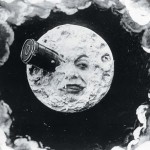 In 1902, Georges Méliès released the first science fiction film, A Trip to the Moon (Le voyage dans la lune). The filmmaker spared no expense for special effects. Review the approximately 11-minute long film and consider the following questions. Do any aspects of the film recall the practices of early photography? What are some differences and similarities between the photographic camera and the film camera?
In 1902, Georges Méliès released the first science fiction film, A Trip to the Moon (Le voyage dans la lune). The filmmaker spared no expense for special effects. Review the approximately 11-minute long film and consider the following questions. Do any aspects of the film recall the practices of early photography? What are some differences and similarities between the photographic camera and the film camera?
There are many copies on the web of various degrees of quality. The quality of the following version on YouTube is very good.
Georges Méliès’ A Trip to the Moon
Please post your responses and comments by Saturday, April 14. Apologies for mis-setting the release time on the blog post last week (this should have appeared then!) I’ve extended the comment time on this so that you can post over Spring Break.




Yes, there are aspects of the film that recall the practices of early photography. For examples: the idea of transforming photography into an art by creating photographs that tell a story, such as, Fading Away and the Two Ways of Life. Also, this film remained me of the notion of “Manifest Destiny” where photos, such as, Cape Horn and others, were used to tell people to go to explore the western lands and this film is doing the same thing. It is enforcing the idea of going to the moon and explores it to the people those days. In addition, the film camera on this film is not moving (it is still) because filmmakers didn’t have the idea of moving the camera to follow the subjects.
A photographic camera produces products that has no sense of motion involved, no special effects, no sound, focuses more on the details of the subjects, and captures only one moment.
A film camera produces products that has motion involved , with special effects, with music play as a background, focuses more in telling a story than capturing the details of the subjects, captures different moments and able to ensemble them together.
They both can make products that tell a story, make an impact on people, subjects are staged and customized in order to characterize them.